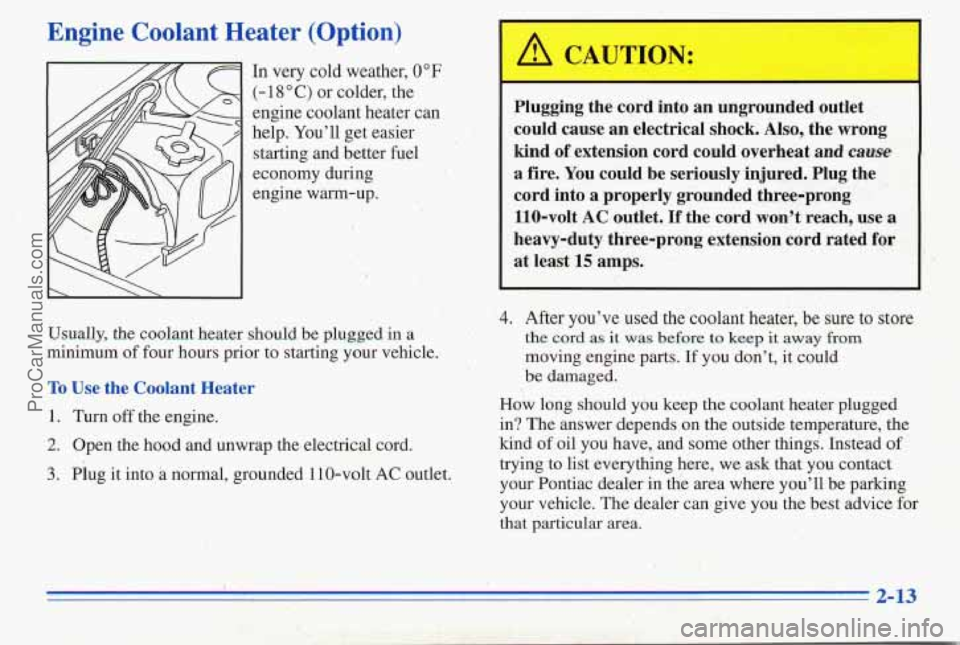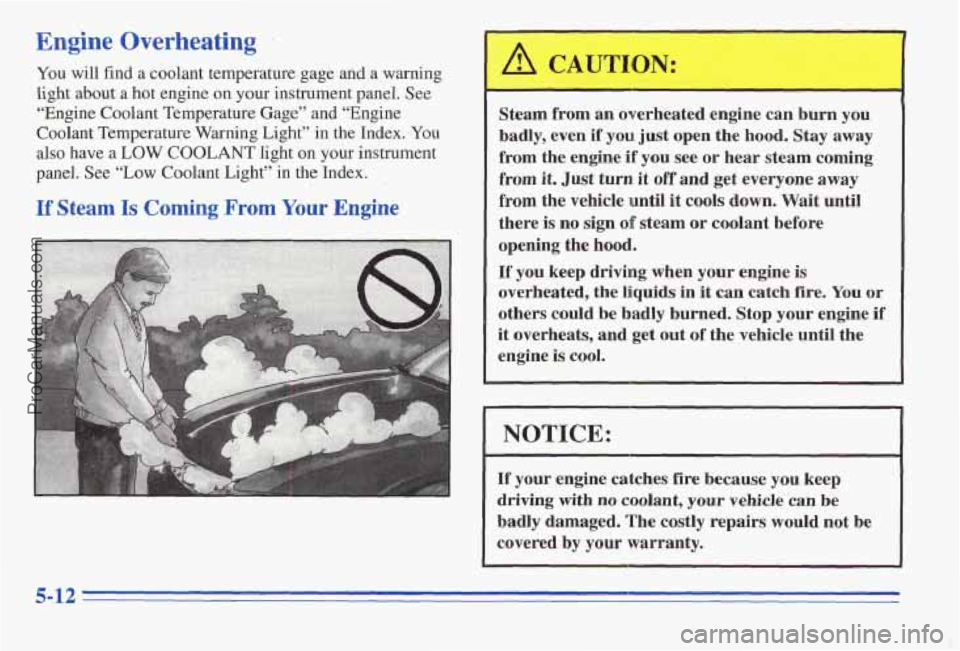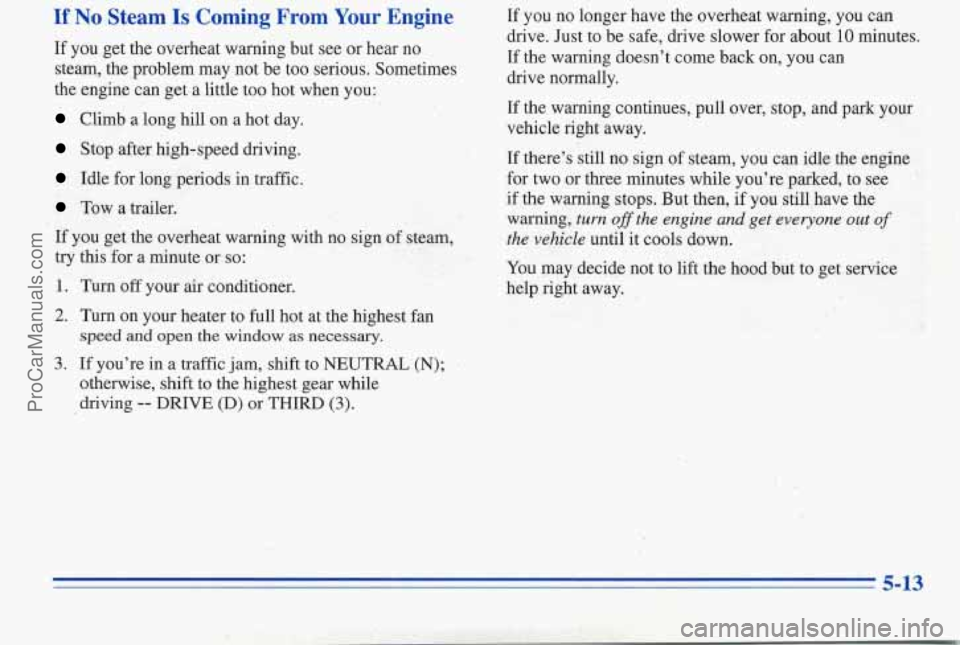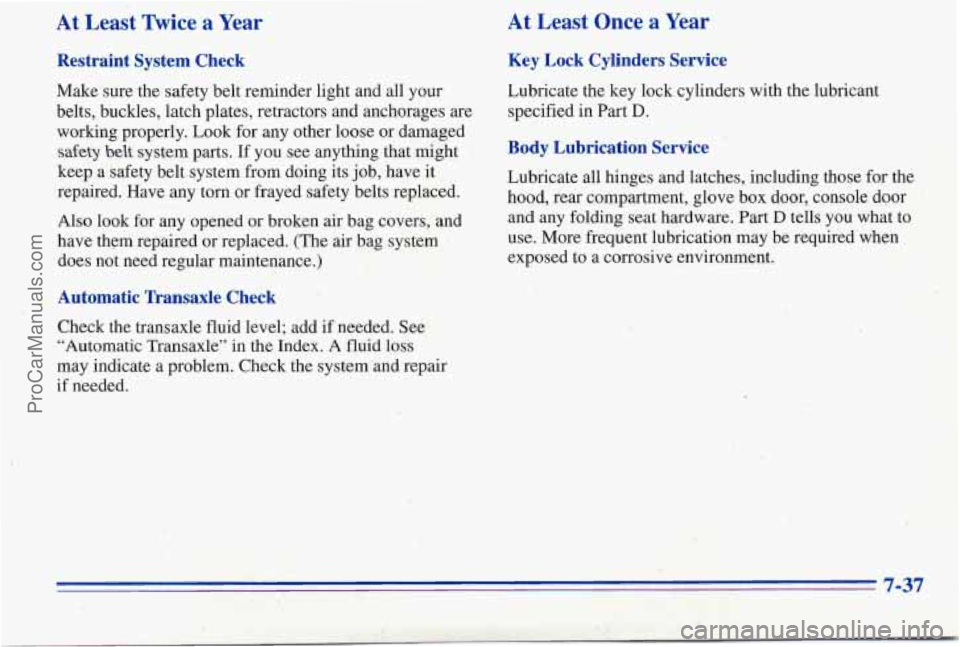Page 82 of 370

Engine Coolant Heater (Option)
In very cold weather, 0" F
(- 18 O C) or colder, the
engine coolant heater can
help. You'll get easier
starting and better fuel
economy during
engine warm-up.
A I
I A CAUTION: I
Plugging the cord into an ungrounded outlet
could cause an electrical shock. Also, the wrong
kind
of extension cord could overheat and cause
a fire. You could be seriously injured. Plug the
cord into a properly grounded three-prong 110-volt AC outlet.
If the cord won't reach, use a
heavy-duty three-prong extension cord rated for
I at least 15 amps.
4. After you've used the coolant heater, be sure to store
Usually, the coolant heater should be plugged in a the cord as it was before to keep it away from
minimum of four hours prior to starting your vehicle. moving engine parts. If you don't, it could
' - be damaged. To Use the- Coolant Heater
How long should you keep the coolant heater plugged
1. Turn off the engine.
in? The answer depends on the outside temperature, the
2. Open the hood and unwrap the electrical cord. kind of oil you have, and some other things. Instead of
.. - .. ' . ':. 1 :\'. . . .. .
~ ~
3. Plug it into a normal, grounded 110-volt AC outlet. trying to list
everything here, we ask that you contact
your Pontiac dealer in tlie area where you'll be parking
your vehicle. The dealer can give you-the best advice for
that particular area,
ProCarManuals.com
Page 205 of 370

Engine Overheating
You will find a coolant temperature gage and a warning
light about a hot engine on your instrument panel. See
“Engine Coolant Temperature Gage” and “Engine
Coolant Temperature Warning Light” in the Index. You
also have
a LOW COOLANT light on your instrument
panel. See
“Low Coolant Light” in the Index.
If Steam Is Coming From Your Engine
Steam from an overheated engine can burn you
badly, even if you just open the hood. Stay away
from the engine
if you see or hear steam coming
from it. Just turn it off and get everyone away
from the vehicle until
it cools clown. Wait until
there
is no sign of steam or coolant before
opening the
hood.
If you keep driving when your engine is
overheated, the liquids in it can catch fire, You or
others could be badly burned. Stop your engine if
it overheats, and get out of the vehicle until the
engine
is cool.
I I
NOTICE:
If your engine catches fire because you keep
driving with no coolant, your vehicle can be
badly damaged. The costly repairs would not be
covered by
your warranty.
5-12
ProCarManuals.com
Page 206 of 370

If No Steam Is Coming From Your Engine
If you get the overheat warning but see or hear no
steam, the problem may not be too serious. Sometimes
the engine can get a little too hot when you:
Climb a long hill on a hot day.
Stop after high-speed driving.
Idle for long periods in traffic.
Tow a trailer.
If you get the overheat warning with no sign of steam,
try this for a minute or
so:
1. Turn off your air conditioner.
2. Turn on your heater to full hot at the highest fan
3. If you’re in a traffic jam, shift to NEUTRAL (N);
speed and open the window as necessary.
otherwise, shift to the highest gear while
driving
-- DRIVE (D) or THIRD (3).
If you no longer have the overheat warning, you can
drive. Just to be safe, drive slower for about
10 minutes.
If the warning doesn’t come back on, you can
drive normally.
If the warning continues, pull over, stop, and park your
vehicle right away.
If there’s still no sign of stem, you can idle the engine
for two or three minutes while you’re parked, to see
if
the warning stops. But then, if you still have the
warning, turn oJffthe engine
and get everyone out of
the vehicle until it cools down.
You may decide not to lift
the hood but to get service
help right away.
5-13
ProCarManuals.com
Page 234 of 370
Hood Release
r To open the hood, first
pull the handle inside
the vehicle.
I
1 Lift the hood.
ProCarManuals.com
Page 292 of 370

Your vehicle has an air bag system. Before attempting to
add anything electrical to your Pontiac, see “Servicing
Your Air Bag-Equipped Pontiac”
in the Index.
Headlamp Wiring
The headlamp wiring is protected by a circuit breaker in
the underhood electrical center. An electrical overload
will cause the lamps to go on and’off, or in some cases
to remain off.
If this happens, have your headlamp
system checked right away.
Windshield Wipers
The windshield wiper motor is protected by a circuit
breaker and a fuse. If the motor overheats due to heavy
snow, etc., the wiper will
stop until the motor cools. If
the overload
is caused by some electrical problem, have
it fixed.
Power Windows and Other Power Options
Circuit breakers in the fuse panel protect the power
windows and other power accessories. When the current
load
is too heavy, the circuit breaker opens and closes,
protecting the circuit until the problem is fixed.
Fuses and Circuit Breakers
The wiring circuits in your vehicle are protected from
short circuits by
a combination of fuses, circuit breakers,
and fusible thermal links in
the wiring itself. This
greatly reduces the chance
of fires caused by
electrical problems.
Look at the silver-colored band inside the fuse. If the
band is broken or melted, replace the fuse. Be sure you
replace abad fuse with a new one of the identical size
and rating.
Instrument Panel Fuse Block
The fuses are in a
fuse block on the
passenger’s side of
the instrument panel.
Pull
off the cover
labeled
FUSES to
expose the fuses.
6-65
ProCarManuals.com
Page 340 of 370

At Least Twice a Year
Restraint System Check
Make sure the safety belt reminder light and all your
belts, buckles, latch plates, retractors and anchorages are
working properly. Look for any other loose or damaged
safety belt system parts. If you see anything that might
keep a safety belt.system from doing its job, have it
repaired. Have any torn
or frayed safety belts replaced.
Also look for any opened or broken
air bag covers, and
have them repaired or replaced. (The air bag system
does not need regular maintenance.)
Automatic Transaxle Check
Check the transaxle fluid level; add if needed. See
“Automatic Transaxle” in the Index. A fluid
loss
may indicate a problem. Check the system and repair
if needed.
At Least Once a Year
Key Lock Cylinders Service
Lubricate the key lock cylinders with the lubricant
specified in
Part D.
Body Lubrication Service
Lubricate all hinges and latches, including those for the
hood, rear compartment, glove box door, console door
and any folding seat hardware.
Part D tells you what to
use. More frequent lubrication may be required when
exposed to
a corrosive environment.
ProCarManuals.com